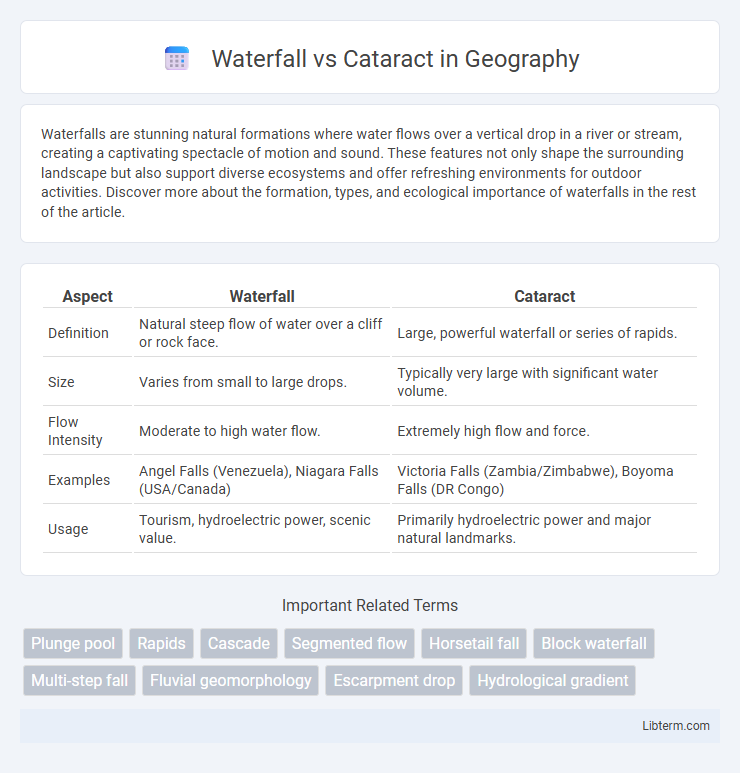Waterfalls are stunning natural formations where water flows over a vertical drop in a river or stream, creating a captivating spectacle of motion and sound. These features not only shape the surrounding landscape but also support diverse ecosystems and offer refreshing environments for outdoor activities. Discover more about the formation, types, and ecological importance of waterfalls in the rest of the article.
Table of Comparison
| Aspect | Waterfall | Cataract |
|---|---|---|
| Definition | Natural steep flow of water over a cliff or rock face. | Large, powerful waterfall or series of rapids. |
| Size | Varies from small to large drops. | Typically very large with significant water volume. |
| Flow Intensity | Moderate to high water flow. | Extremely high flow and force. |
| Examples | Angel Falls (Venezuela), Niagara Falls (USA/Canada) | Victoria Falls (Zambia/Zimbabwe), Boyoma Falls (DR Congo) |
| Usage | Tourism, hydroelectric power, scenic value. | Primarily hydroelectric power and major natural landmarks. |
Introduction to Waterfalls and Cataracts
Waterfalls and cataracts are natural water features characterized by the vertical descent of a river or stream over a cliff or steep incline. Waterfalls tend to be smaller and more scenic, often creating mist and rainbows, while cataracts are larger, powerful cascades with immense water flow and significant erosive force. Both formations result from geological processes like erosion and tectonic activity, highlighting dynamic interactions between water and earth over time.
Defining Waterfall and Cataract: Key Differences
A waterfall is a natural formation where water flows over a vertical drop in a river or stream, creating a continuous flow of water from one elevation to a lower one. A cataract, while similar to a waterfall, typically refers to a large, powerful, and often series of rapids or a massive waterfall with significant volume and force. The key differences lie in scale and intensity: waterfalls can be small and gentle, whereas cataracts are generally larger, more turbulent, and associated with strong currents and impressive water flow.
Geological Formation of Waterfalls vs Cataracts
Waterfalls form when a river's flow encounters a sudden vertical drop in the landscape, typically caused by differential erosion of rock layers with varied resistance, resulting in a steep descent. Cataracts are larger, more powerful rapids or series of waterfalls characterized by turbulent, fast-flowing water over rocky riverbeds, often occurring in regions with extensive bedrock fractures or tectonic activity. The geological formation of waterfalls emphasizes sharp elevation changes, while cataracts highlight intense hydraulic forces shaped by rugged terrain and geological disruptions.
Hydrological Characteristics Compared
Waterfalls are vertical drops in a river's course caused by sudden changes in bedrock elevation, resulting in turbulent, aerated flows with significant energy dissipation. Cataracts, being larger and more powerful rapids or waterfalls, exhibit more intense hydraulic forces, higher flow velocities, and greater erosion potential due to their scale and volume of water. Hydrologically, waterfalls often form where resistant rock overlays softer substrates, while cataracts represent expansive, high-energy river sections with complex flow patterns critical for sediment transport and river morphology.
Visual and Structural Features
Waterfalls are large, vertical drops in rivers characterized by a continuous flow of water over a cliff or steep incline, often creating spray and mist with varying widths and heights. Cataracts are intense, turbulent sections of a river with powerful rapids and strong currents, typically featuring rocky, uneven riverbeds and causing significant water agitation and foam. Both exhibit dynamic visual features, but waterfalls emphasize vertical descent and scenic splendor, while cataracts highlight forceful water movement and structural ruggedness.
Famous Examples Around the World
Victoria Falls, located on the border between Zambia and Zimbabwe, is renowned as the largest waterfall with a width of about 1,708 meters and a height of 108 meters, creating the famous "smoke that thunders" effect. Niagara Falls, straddling the United States and Canada, is one of the most visited cataracts globally, featuring a combined flow rate of over 2,400 cubic meters per second across its three sections: Horseshoe, American, and Bridal Veil Falls. Iguazu Falls on the Argentina-Brazil border boasts approximately 275 cascades spanning nearly 2.7 kilometers, making it one of the most spectacular cataracts due to its massive system of segmented waterfalls.
Ecological Impact of Waterfalls and Cataracts
Waterfalls create unique microhabitats that support diverse plant and animal species by aerating water and maintaining cool temperatures, which foster rich aquatic ecosystems. In contrast, cataracts, characterized by intense, turbulent water flows, can significantly alter river morphology and sediment transport, impacting fish migration and nutrient distribution. Both features influence biodiversity differently, with waterfalls enhancing localized ecological niches while cataracts contribute to broader geomorphological changes affecting aquatic habitats.
Tourism and Economic Contributions
Waterfalls, such as Niagara Falls, draw millions of tourists annually, significantly boosting local economies through hospitality, guided tours, and recreational activities. Cataracts, characterized by powerful whitewater rapids like those on the Zambezi River, attract adventure tourists interested in rafting and extreme sports, generating substantial revenue for surrounding communities. Both natural features enhance regional economic contributions by supporting employment and promoting sustainable tourism development.
Conservation Challenges and Efforts
Waterfalls and cataracts face significant conservation challenges due to habitat disruption, pollution, and unmanaged tourism impacting their ecosystems. Efforts to preserve these natural features include implementing strict environmental regulations, promoting sustainable ecotourism, and engaging local communities in conservation activities. Monitoring water quality and flow rates is essential for maintaining biodiversity and preventing ecological degradation in these dynamic freshwater environments.
Choosing the Right Term: Waterfall or Cataract?
Choosing between the terms "waterfall" and "cataract" depends on context and scale, as waterfalls generally describe any flowing water dropping from a height, whereas cataracts refer specifically to large, powerful waterfalls often characterized by strong currents and significant geological features. In scientific and geographical writing, using "cataract" emphasizes grandeur and force, ideal for large cascades like the Cataract of the Nile. For tourism or casual descriptions, "waterfall" remains the preferred term due to its broad recognition and applicability across various sizes and settings.
Waterfall Infographic

 libterm.com
libterm.com